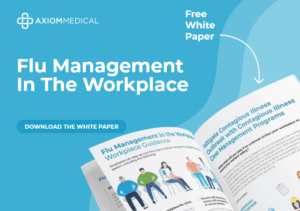Extreme heat territory starts when the heat index reaches 90°F or higher. At this point, the body must work much harder to keep itself cool.
If workers at your organization regularly encounter this temperature threshold, then it’s vital that you understand the importance of the heat index.
The Heat Index Explained
Weather forecasts use the heat index because it reflects how temperature and humidity together affect the human body. You’ll often see it referred to as the “real feel.” For example, if it’s 90°F but the humidity is high, like 70%, it might feel closer to 105°F. That’s because the extra moisture in the air makes it harder for your sweat to evaporate, which is your body’s process for cooling itself down.
So don’t just trust the air temperature alone—it’s what heat feels like that impacts your team’s safety and performance.
How to Interpret Heat Index Numbers Safely
Heat index levels can be classified into risk zones for better safety planning. Here’s what the numbers mean for outdoor workers:
Heat Index |
Risk Level |
Worker Impact |
| 81°F – 89°F | Low Caution | Fatigue possible with prolonged exposure and physical activity. |
| 90°F – 103°F | Moderate Risk | Heat exhaustion becomes a concern, especially with longer or intense jobs. |
| 103°F – 124°F | High Risk | Likely to cause heat exhaustion quickly; rest breaks are critical. |
| 125°F and higher | Extreme Danger | Very high risk of heat stroke; work should be minimized or halted entirely. |
Use this chart to plan your workday around the heat index. If the heat index rises into the high-risk zone, you’ll need to adopt additional precautions.
Tips for Staying Safe Based on the Heat Index
Every job site and workday is different, but when heat index levels rise, these practical strategies can help mitigate risks:
Hydrate, Hydrate, and Hydrate
- Workers should stay ahead of dehydration by drinking 16-20 ounces of water before work starts and then continue consuming 6-8 ounces every 20 minutes during their shift.
- For heat index levels above 90°F, electrolyte-replenishing drinks can be helpful when paired with water.
- Avoid caffeinated or sugary drinks, which can increase dehydration.
Let the Sun Decide Start Times
- Start earlier or end later to avoid working during peak heat, which typically takes place between 12 p.m. and 4 p.m.
- Divide tasks into shorter, manageable intervals, and frequently cycle between high-intensity and lighter tasks.
Siestas are Smart
- Work-rest cycles are necessary to prevent heat-related fatigue. Physical labor makes workers feel hotter.
- The higher the heat index, the longer and more frequent rest should be.
Dress for Success
- Workers should wear light-colored, loose-fitting clothing made of breathable, moisture-wicking materials.
- Utilize protective accessories like wide-brimmed hats, bandanas soaked in cold water, and wearables to monitor symptoms.
Be Symptom-Savvy
- If you notice symptoms in yourself or anyone on the premises, stop working immediately and seek shade or medical attention. Pay attention to signs of heat-related illnesses:
- Heat exhaustion: Excessive sweating, dizziness, weakness, nausea.
- Heat stroke: Dry skin, confusion, rapid pulse, and loss of consciousness (this is an emergency).
Push for Policies that Protect
- Worksites should provide access to shaded rest areas, cooling stations, and water on-site.
- Workplaces with consistent outdoor labor should also implement buddy check systems, ensuring employees monitor one another for heat stress symptoms.
Heed the Heat Index
- On days with extreme heat advisories, employers should strongly consider adjusting the schedule or workload. Stay informed by following local weather updates or using OSHA’s Heat Safety Tool App.
- A wet bulb globe temperature (WBGT) monitor is also recommended to calculate heat levels in the workplace.
Watch Heat Stress Prevention: Keeping Your Cool as Temperatures Rise
- Hosted by Axiom’s Chief Medical Officer, Dr. Scott Cherry, and James Ryan, the Chief Revenue Officer of the groundbreaking wearables company Epicore Biosystems, we’ll gain important insights into what to do when the heat takes a toll — before it becomes a crisis.










